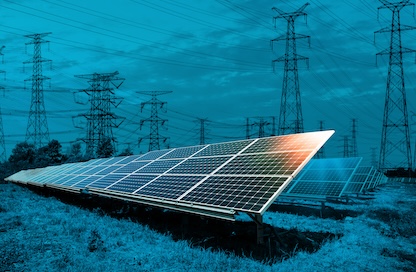Electricity
Electricity policies reduce emissions produced by the generation, transmission, and distribution of electricity. Emissions in this sector are largely derived from the combustion of fossil fuels — such as coal, oil, and natural gas — to produce electricity. Electricity policies increase the deployment of clean and renewable electricity, reduce fossil fuel-based electricity production, and modernize transmission and distribution systems in order to support a zero-emissions grid.

13
Policies
| Policy | Policy Category | Components | Enacted | |
|---|---|---|---|---|
|
Clean energy standards and renewable portfolio standards set a target for a specific amount of clean or renewable electricity the state must generate by a certain year, often with incremental targets over time. |
Energy Plans and Targets | 0 components | 35 states | |
|
Electricity greenhouse gas (GHG) emissions reduction targets are set by a state to limit GHG emissions in the electricity sector. These targets aim to reduce emissions by different amounts over time, often expressed as percentage relative to a baseline year. |
Energy Plans and Targets | 0 components | 9 states | |
|
Clean energy plans are documents that outline the policies and strategies states can implement to meet clean energy targets. Draft plans are often published first, and after a period of public comments and revisions, a final plan is released. |
Energy Plans and Targets | 0 components | 16 states | |
|
States can establish some form of statewide, consolidated siting and permitting entity — typically a council or board — for renewables and/or transmission to streamline project review and prevent uncertainty in the face of local governments’ restrictions or prohibitions of renewable generation or transmission. |
Permitting and Grid Integration | 0 components | 14 states | |
|
Interconnection standards create a streamlined, affordable and predictable set of procedures and requirements for connecting new distributed energy resources safely and reliably to the grid. |
Permitting and Grid Integration | 0 components | 37 states | |
|
Advanced transmission technologies (ATTs) and grid enhancing technologies (GETs) are a family of technologies that can enhance the capacity of the existing electrical transmission and distribution system. State policies that promote ATTs and GETs can be key to unlocking renewable energy development at lower cost and with shorter wait times. |
Permitting and Grid Integration | 0 components | 15 states | |
|
Net metering allows a customer to be credited for selling energy they generate back to the utility company and establish rules for the transactions.
This policy is only considered enacted if a state fulfills all components of that policy.
|
Permitting and Grid Integration | 11 components | 1 state | |
|
Shared renewables policies allow for shared solar systems that have multiple owners or subscribers, each of which pays for a portion of generation from the shared system.
This policy is only considered enacted if a state fulfills all components of that policy.
|
Incentivizing Clean Energy Resources | 6 components | 3 states | |
|
Community choice aggregation allows local governments to procure power on behalf of their residents, businesses, and municipal accounts from an alternative supplier while still receiving transmission and distribution service from their existing utility provider. |
Incentivizing Clean Energy Resources | 0 components | 10 states | |
|
Distributed generation carve-outs require that a certain percentage of electricity generation used to meet a state's renewable portfolio standard (RPS) comes from distributed generation or small-scale solar.
This policy is only considered enacted if a state fulfills all components of that policy.
|
Incentivizing Clean Energy Resources | 5 components | 7 states | |
|
Energy storage targets establish procurement targets for energy storage systems by a certain date, often with interim targets. Targets can vary from broad megawatt (MW) requirements to more specific mandates that focus on the adoption of certain storage technologies. |
Incentivizing Clean Energy Resources | 0 components | 13 states | |
|
Coal phaseouts establish a target year by which states must end coal-fired power generation. |
Coal Retirement | 0 components | 12 states | |
|
Coal securitization is a financing tool that allows utility companies to refinance debt they issued to build coal plants and close the facilities early without taking a financial hit or passing costs on to ratepayers. |
Coal Retirement | 0 components | 10 states |